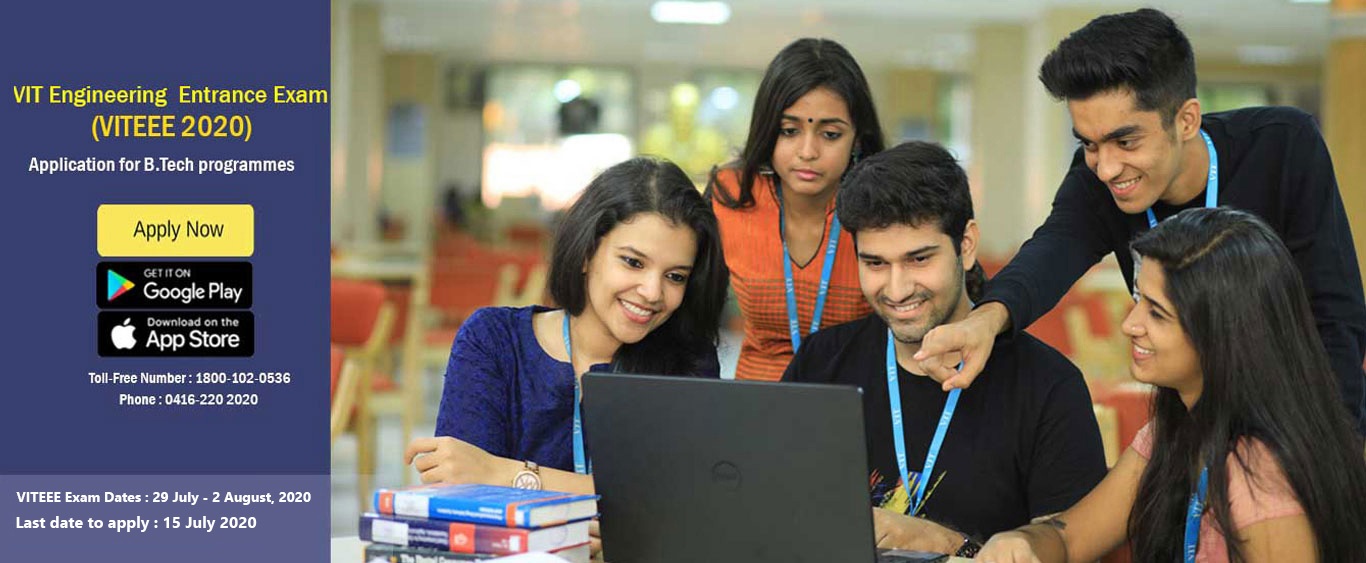VIT VITEEE 2020 Syllabus : Engineering Entrance Exam
Organisation : Vellore Institute of Technology
Exam Name : VIT Engineering Entrance Examination VITEEE
Service Name : VITEEE 2020 Syllabus
Website : https://viteee.vit.ac.in/
VIT VITEEE Exam
VITEEE is a common entrance exam for VIT Vellore, VIT Chennai, VIT-AP and VIT- Bhopal.
Related / Similar Syllabus : VIT VITEEE 2021 Syllabus

VITEEE Syllabus
Physics
1. Laws of Motion & Work, Energy and Power:
Law of conservation of linear momentum and its applications. Static and kinetic friction – laws of friction – rolling friction – lubrication. Work done by a constant force and a variable force; kinetic energy – work-energy theorem – power. Conservative forces: conservation of mechanical energy (kinetic and potential energies) – non-conservative forces: motion in a vertical circle – elastic and inelastic collisions in one and two dimensions.
2. Properties of Matter:
Elastic behaviour – Stress-strain relationship – Hooke’s law – Young’s modulus – bulk modulus – shear modulus of rigidity – Poisson’s ratio – elastic energy. Viscosity – Stokes’ law – terminal velocity – streamline and turbulent flow – critical velocity. Bernoulli’s theorem and its applications. Heat – temperature – thermal expansion: thermal expansion of solids – specific heat capacity: Cp, Cv – latent heat capacity. Qualitative ideas of Blackbody radiation: Wein’s displacement Law – Stefan’s law.
3. Electrostatics:
Charges and their conservation; Coulomb’s law-forces between two point electric charges -Forces between multiple electric charges-superposition principle.Electric field –electric field due to a point charge, electric field lines; electric dipole, electric field intensity due to a dipole -behaviourof a dipole in a uniform electric field.
Electric potential -potential difference-electric potential due to a point charge and dipole-equipotential surfaces –electrical potential energy of a system of two point charges.Electric flux-Gauss’s theorem and its applications.
Electrostatic induction-capacitor and capacitance –dielectric and electric polarisation –parallel plate capacitor with and without dielectric medium –applications of capacitor –energy stored in a capacitor -Capacitors in series and in parallel –action of points –Van de Graaff generator.
Chemistry
1. Atomic Structure:
Bohr’s atomic model-Sommerfeld’s extension of atomic structure; Electronic configuration and Quantum numbers; Shapes of s,p,d,f orbitals – Pauli’s exclusion principle – Hund’s Rule of maximum multiplicity- Aufbau principle.
Emission and absorption spectra, line and band spectra; Hydrogen spectrum – Lyman, Balmer, Paschen, Brackett and Pfund series; deBroglie’s theory; Heisenberg’s uncertainty principle – wave nature of electron – Schrodinger wave equation (No derivation). Eigen values and eigen functions. Hybridization of atomic orbitals involving s,p and d orbitals.
2. p,d and f – Block Elements:
p-block elements – Phosphorous compounds; PCl3, PCl5 – Oxides. Hydrogen halides, Inter halogen compounds. Xenon fluoride compounds. General Characteristics of d – block elements – Electronic Configuration – Oxidation states of first row transition elements and their colours.
Occurrence and principles of extraction: Copper, Silver, Gold and Zinc. Preparation and properties of CuSO4, AgNO3 and K2Cr2O7. Lanthanides – Introduction, electronic configuration, general characteristics, oxidation state – lanthanide contraction, uses, brief comparison of Lanthanides and Actinides.

Mathematics
1. Matrices and their Applications:
Adjoint, inverse – properties, computation of inverses, solution of system of linear equations by matrix inversion method. Rank of a matrix – elementary transformation on a matrix, consistency of a system of linear equations, Cramer’s rule, non-homogeneous equations, homogeneous linear system and rank method. Solution of linear programming problems (LPP) in two variables.
2. Trigonometry and Complex Numbers:
Definition, range, domain, principal value branch, graphs of inverse trigonometric functions and their elementary properties. Complex number system – conjugate, properties, ordered pair representation. Modulus – properties, geometrical representation, polar form, principal value, conjugate, sum, difference, product, quotient, vector interpretation, solutions of polynomial equations, De Moivre’s theorem and its applications.
Roots of a complex number – nth roots, cube roots, fourth roots.
Biology
1. Taxonomy:
Need for classification; three domains of life. Linnaean, Whittaker, Bentham and Hooker systems of classification. Salient features and classification of non-chordates up to phyla levels and chordates up to class levels. Morphology and anatomy of flowering plants. Structural organization in insects(cockroach)
2. Cell and Molecular Biology:
Cell theory. Prokaryotic cell and it’s ultrastructure. Eukaryotic cell- cell wall, cell membrane, cytoskeleton, nucleus, chloroplast, mitochondria, endoplasmic reticulum, Golgi bodies, ribosomes, lysosomes, vacuoles and centrosomes. Cell cycle and division – amitosis, mitosis and meiosis. Search for genetic material; structure of DNA and RNA; replication, transcription, genetic code, translation, splicing, gene expression and regulation (lac operon) and DNA repair.
English & Aptitude
English :
Questions on English and it will be Multiple Choice Questions testing the comprehension of a short passage or line of poems, English grammar and pronunciation. Please note that the passages, lines of poems, dialogues, grammar and pronunciation items are chosen to suit the level of higher secondary or equivalent education.
Aptitude :
Assessment will be the following topics.1. Data Interpretation2. Data Sufficiency3. Syllogism4. Number series, Coding and Decoding5. Clocks, Calendars and Directions
Important Downloads
Physics Syllabus :
http://www.syllabus.gen.in/uploads/pdf2020/1701-Physics.pdf
Chemistry Syllabus :
http://www.syllabus.gen.in/uploads/pdf2020/1701-Chemistry.pdf
Maths Syllabus :
http://www.syllabus.gen.in/uploads/pdf2020/1701-Maths.pdf
Biology Syllabus :
http://www.syllabus.gen.in/uploads/pdf2020/1701-Biology.pdf
English & Aptitude Syllabus :
http://www.syllabus.gen.in/uploads/pdf2020/1701-Eng.pdf